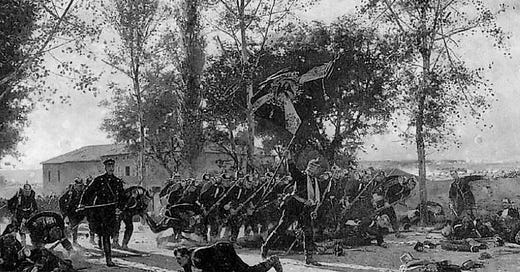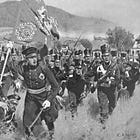This is the tenth post in a multi-part series. To find previous installments and those that follow, please consult the following guide.
The sights were adjusted, and each man had some cartridges placed ready between the breast buttons of his coat. On the platoons of a company coming in sight of the enemy’s line they halted together, and each fired a volley, standing. They were doubled on to a place whence they could fire lying down. The commands for this movement were ‘Ready,’ ‘Present,’ ‘Fire,’ ‘Load,’ and then immediately ‘Double march. As the center of the firing lines of the regiment came in sight of the enemy first, and were therefore sooner under fire than the wings, they supported the advance of the latter by their volleys.
The enemy’s infantry on the village height had ceased firing a little time before. When, however, our artillery burst a fresh shower of shrapnel over their shelter trenches, and our firing line, whose helmets only were visible, thundered their first volley from the crest of the hill, the rolling fire of the opposing force began afresh with great vehemence. The enormous mass of their projectiles had a tremendous effect on us.1
The first firing place was reached in the best form. The 1st Regiment now commenced on their side a brisk volley fire. The volleys were not always as crisp as one hears on parade. A great number of them were absolute failures, which sometimes led to the fire getting out of hand.
When such a thing happened all the whistles sounded, and not only those in the platoons concerned, but all those of the neighboring platoons, unless they themselves happened not to be firing at the time. Not until every trace of irregular firing had been stopped in this manner, were the platoons again allowed to fire volleys at their own direction. The most ruthless means were employed against this irregular fire, and each officer was responsible for his command. I saw that, in the first moments of disorder, the platoon leaders and their under platoon leaders did not immediately rush at the men who were shooting wildly, but turned to their section leaders and peremptorily ordered them to go to their sections and use every means in their power to put an end to the excited firing.
The leaders, whether officers, sergeants, or lance corporals, were not allowed to content themselves with lying down looking on from cover, in rear of the firing line, but had to expose themselves when necessary to put an end to any disorder or restlessness in their detachments. They knew that after the fight no forbearance would be shown to anyone who had neglected his duty in such matters. The chief method of keeping the men calm consisted in repressing any rising excitement, and punishing it by a longer pause in the firing.
Hallen had said: ‘One shot fired coolly is worth more than twenty nervous shots. The more fire pauses, and the longer they are, the better. We save cartridges, and therefore hit so many the more afterwards. When the whistle sounds all along the line, and all firing suddenly stops, so much the better.
Whoever asserts that this will encourage the enemy to shoot better, knows nothing about war. Every soldier in the enemy’s line knows full well that this uncanny silence will be the prelude to a louder peal of thunder. He ducks at once before the deadly blow, which he expects. His uneasiness becomes greater, and will go on increasing when the silence is prolonged.’
Among other things, I noticed that no blame was attached to a soldier if he pulled his trigger at the word of command of a neighboring platoon leader, neither was he blamed for not executing the order of his own leader; so long as order was maintained and he did not.
‘That is the true old Prussian fire discipline,’ I exclaimed; ‘what on earth made us doubt its impossibility so long? Was it not possible in the last century, when the losses were actually greater and occurred in a much shorter space of time than today, when battalions consisted of crimped foreigners and militia? It is true the modern rifle shoots three or four times as quickly as the old musket, but this made the old fire tactics ten times as ruthless.’
Close order lines standing upright would dash their volleys in each other’s faces at 100 yards distance. There are very few of Frederick’s battles in which entire regiments, yes, even entire wings of the army, did not lose half their numbers in a few minutes. Yet the practicability of platoon volleys was not disputed then, though their volleys were much more slow and pedantic than those I am looking at.
The center of the firing line was about 550 yards, and its wings 650 yards from the enemy. There was not much delay at this distance. After a few volleys the advance was carried on by rushes. This advance was left entirely to the discretion of the platoon leaders. The only hard and fast rule was, that when a platoon had advanced it must be fol- lowed by the others of its company as soon as possible.
Now, from this it will be seen that the advance of the platoons of the same company had neither to be exactly simultaneous or in the same direction. The platoon which had taken the initiative was in front, the others had to follow as quickly as they could. On the other hand, each platoon must rise quickly and together, close up during the rush, and be halted in formation at the desired place before lying down.
It was a strict order that on a platoon advancing, the platoons on either side, if not clear of it by an interval of 25 yards, were immediately to cease firing, half-cock the rifles, and keep them in an upright position.
‘The greatest obstacle to a dashing advance,’ said Hallen, ‘is not the danger from the enemy’s bullets, every one anticipates and is prepared for that, but the losses which are inflicted in the rear by the rifles of your own comrades. This danger must be absolutely abolished or there can be no hope of success in an attack.
Can this, however be accomplished so long as irregularity, getting out of hand, and mobs are regarded as inevitable? How to diminish the losses the enemy inflicts on us is a problem that many men have puzzled their heads over; but I have neither heard nor read of any suggestions as to the best means of avoiding the far greater losses caused by the fire of comrades in rear.’
It can be easily understood that in such an advance by platoon rushes, where the platoons closed in towards the center, the intervals between the platoons of a company were not always strictly preserved. When such an error occurred it was the duty of the leader of the platoon in question to rectify it during the next rush. It happened once that the flanks of two platoons overlapped, but no disturbance or difficulty ensued. The wings locked up without mixing, and where this occurred they fired in two ranks, the front rank lying down and the rear rank kneeling.
‘Stand back’, commanded an under platoon leader, a sergeant, to two men.2 They had been a little late both in rising and rushing forward, and were now endeavoring to push their way into their places after the platoon had closed without them, and were lying down.
‘Don’t make room for those lazy fellows’, the sergeant shouted to the other men. So the laggards had to make a rear rank and fire kneeling while the others lay. ‘Kneel properly, and don’t crouch’, added the sergeant. ‘If you are the first in the next rush you will get your places again.’ I think there can be little doubt that these men were the first in the next rush.
‘Up,’ shouted a lieutenant to his platoon, who after the rush had thrown themselves down hastily and in disorder without waiting for the order ‘down.’ ‘Up,’ repeated the officer, hitting over the shoulders with the flat of his sword a man who in his anxiety had begun to fire. By main force all were got up again, several were struck and fell again to the earth. ‘Without step … march’, ordered the platoon leader. ‘Close.’ When the platoon was again in order, when the gaps left by the fallen were closed and the proper position taken up. ‘Down.’ In an instant all were lying prostrate and immediately afterwards cracked out an excellent volley.
‘Are there not still many people who would call this a useless sacrifice of human life?’ I asked myself. The platoon would have lost six men less if the leader had let them lie where they threw themselves at first. ‘And even if twenty men had fallen’, I exclaimed, ‘I would stand up for this brave officer, who exposed himself more than anyone else. Twenty disciplined men in order are worth more than forty out of hand, who blaze into the sky and hinder each other from shooting.’
The left company had begun rushes almost at once. The right flank company, which was the farthest from the enemy, had advanced of its own accord. The central companies followed as soon as these had opened fire.
A central company had started the second rush, which then extended to the flanks by companies.
To be continued …
Soon after an installment of this series appears in the pages of The Tactical Notebook, a link to it will appear on the following guide.
In this context, ‘shrapnel’ refers to ‘shrapnel shells’, projectiles designed to burst after flying for a set time, thereby releasing a large number of small lead balls. (Note the difference between this meaning and the more recent use of the word to describe any sort of fragments created by an explosion.)
As used here, ‘under leader’ refers to a man who has been pre-designated to take charge of a platoon, half-platoon, or squad in the absence of the original leader.






